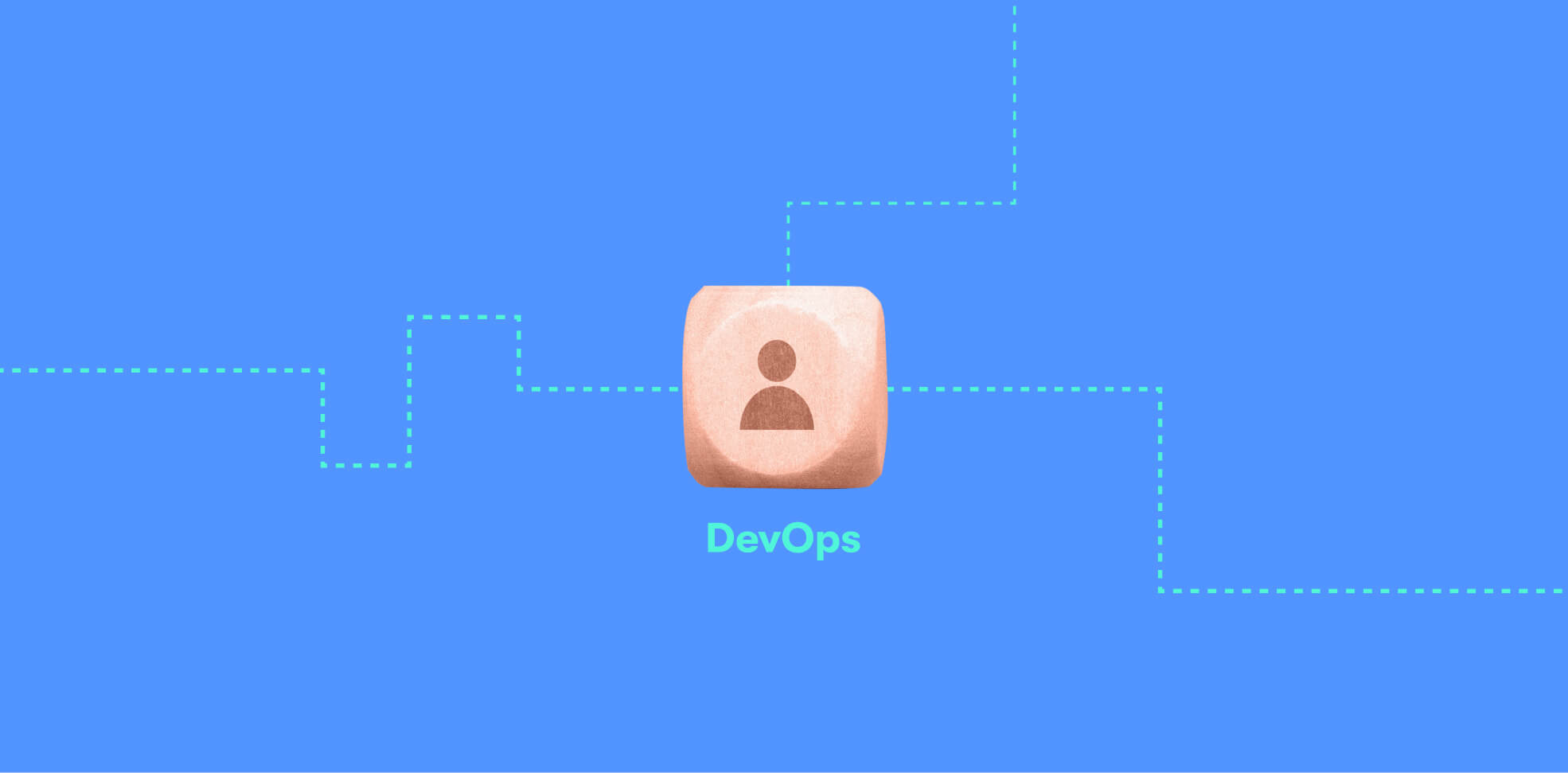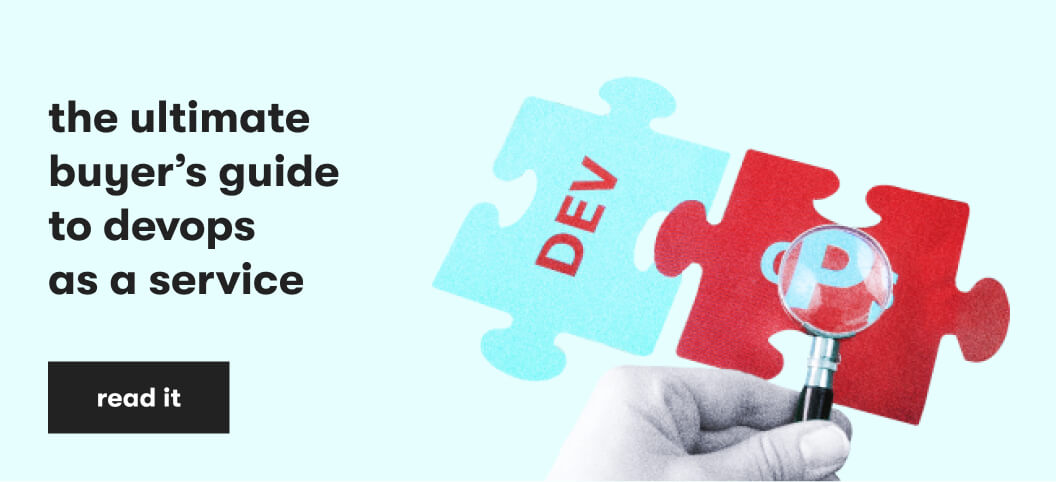To overcome the shortcomings and limitations of the traditional way of developing software and performing IT operations, it is worth considering the DevOps methodology. Startups that choose this approach can create stable and reliable end products faster and more efficiently.
DevOps stands for software development and operations and strives to harmonize them using defined processes, practices, and tools. According to statistics, DevOps is the most popular software development methodology practiced worldwide. And this is quite reasonable. Implementing this approach helps reduce the gap between developers and end users and is responsible for accelerating the development life cycle and improving the quality of end products.
This article discusses DevOps strategy, principles, phases, tools, and best practices. We find out the reasons to implement this methodology in a startup, consider its key takeaways, define DevOps setup steps, and show how to implement DevOps.
How DevOps Principles Bring Value to a Startup
In general, DevOps services are a way to improve the software development process and IT operations. If the DevOps environment is set up properly, engineers only need to commit their changes to the codebase. The DevOps platform provides further testing, deployment, and maintenance of the software product.
The strategy’s core principles cover collaboration within a team to ensure a seamless relationship between coding, testing, and deployment, as well as a focus on the result and a customer-centric approach. Other fundamental principles are related to automating repetitive and routine tasks, continuous improvement, and continuous monitoring of the end product's performance.
DevOps Strategy
A DevOps strategy solves many business challenges for startups, including keeping up with changing market trends, meeting ever-evolving customer needs, expanding organizational capabilities, accelerating software development, reducing time to market for final products, and many others.
This methodology is a multipurpose solution that integrates development and operations aspects throughout all product delivery cycles while providing high quality and absolute reliability.
An effective, high-quality, and winning strategy for the DevOps implementation process relies on many key factors, such as:
- high speed and rapid innovation;
- fast delivery;
- continuous integration practices;
- reliable operations;
- positive customer experience;
- scale and effective management of all stages of the software lifecycle (development, testing, and production);
- advanced collaboration and efficiency improvement;
- solution of all security problems.
DevOps Phases
DevOps practice covers a wide range of DevOps processes, and its implementation is carried out in several stages.
So, the first phase is related to source code management. Coding is the hardest part of software development. Developers are responsible for creating different parts of the product and then moving their part of the work into a shared codebase available to all developers. The DevOps culture requires the entire team to work according to common rules and performs coordinated and consistent workflows.
The next stage is testing. When the code developed by different team members is collected in one base, engineers start constructing the final product, which DevOps semi-automates. And when the code is compiled, the next task is to conduct testing and quality assurance in manual and automated modes.
After testing, it’s time to move on to deployment and hosting. In the deployment phase, the code is loaded into the production environment, which, unlike the testing one, is public and relies on genuine data. DevOps ensures that deployment runs without downtime.
The last stage of DevOps is support and monitoring. The software never stops evolving, so you must keep monitoring the product's performance. This methodology works in cycles. The statistics collected during maintenance and monitoring are transferred to the development phase for code modification and refinement, providing improved reliability and increased flexibility.
DevOps Tools
Engineers use different toolkits to achieve diverse goals, perform various tasks, and conduct specific DevOps processes within the DevOps project. Let's look at the main ones.
- Configuration management: Puppet, Ansible, Salt, Chef.
- Virtual infrastructure: Amazon Web Services, VMware vCloud, Microsoft Azure.
- Continuous integration: Jenkins, GitLab, Bamboo, TeamCity, CircleCI.
- Continuous delivery: Docker, Maven.
- Continuous deployment: AWS CodeDeploy, Octopus Deploy, DeployBot, GitLab.
- Continuous testing: Selenium, Appium, Eggplant, Testsigma.
- Container management: Cloud Foundry, Red Hat OpenShift.
- Container orchestration: Kubernetes, Apache Mesos, OpenShift, Docker Swarm, Rancher.
These tools are popular and effective, and picking an appropriate stack is critical to successfully implementing DevOps strategies.
The Emerging Role of AI and ML in DevOps
As DevOps continues to evolve, the integration of Artificial Intelligence (AI) and Machine Learning (ML) is becoming increasingly significant. These technologies are revolutionizing DevOps by enhancing automation capabilities, enabling predictive analytics for system performance, and refining decision-making processes. The application of AI and ML in DevOps leads to more proactive problem resolution, optimized resource management, and overall system efficiency improvements. This forward-looking approach not only streamlines operations but also paves the way for more intelligent and responsive software development environments, marking a significant leap in the evolution of DevOps practices.
DevOps Best Practices
To ensure a successful DevOps implementation approach, the team must know and apply advanced practices for its projects. Our top proven practices will help you develop a winning solution.
First, always assess the needs of your business to determine whether it requires DevOps. Also, always remember that customer satisfaction is the number one priority for all processes, and DevOps is no exception. Another proven strategy is to start small: this is what effective DevOps is based on—breaking up a large project into small steps.
In addition, one of the critical aspects of success is the introduction of automation, wherever it can be beneficial to gain time, effort, and money. Do not forget that you need to work only with tools suitable for the environment and compatible with each other. Last but not least is the need to design a feedback tool responsible for transparency, enhancing trust, and promptly identifying all weaknesses.
CREATE THE BEST DEVOPS STRATEGY FOR YOUR STARTUP WITH EPAM STARTUPS & SMBS
Our team relies on proven best practices, allowing us to make a truly win-win DevOps implementation strategy. Bring added value to your startup.
Reasons to Implement DevOps in Your Project
Now, let’s find out the key advantages that the DevOps methodology brings to the business. Why implement this solution in a startup? What results can be expected, and what are its practical values for a business?
Quick Response to Changing Business Needs
DevOps allows you to release software faster and in smaller pieces, to react faster and more flexibly to new business requests that will emerge at different implementation stages. This will lead to faster entry to the market, as well as more cycles and stages to revise the end product.
Implementing a Data-driven Culture
At the core of DevOps is a solution that effectively brings development and operations together. This results in a higher project delivery speed and allows businesses to rely more on their data.
Improving Teamwork and Communication
In a company where the workflows are based on DevOps, collaboration within the team is more flexible, transparent, and productive. This kind of approach to development allows being open to experiments, actively introducing innovations, constantly receiving feedback, and having clear boundaries of areas of responsibility. All this leads to increased trust, a high level of mutual understanding, and effective cooperation.
Performance Boost
DevOps goes hand in hand with automation, and the automatic execution of elementary tasks allows the team to concentrate on more important things. Also, it minimizes the impact of the human factor on routine processes. All this inevitably leads to enhanced efficiency, faster improvements, fixed bugs, and improved development processes.
Shortening the Development Cycle
One of the main goals DevOps achieves is the prompt delivery of the end product. The available optimization options and automation tools play a key role in this. The development and operations team partnership results in development cycle reduction, faster software release, and earlier readiness for use.
Reduced Development Costs
Reduced development costs are achieved through the joint partnership of coders, testers, and engineers using automated testing capabilities. This approach cuts operating costs since maintenance and upgrades are merged into one direction. In addition, thanks to the DevOps solution, manual tasks are automated, saving developers time and thus the project budget.
Enhanced User Trust and Customer Experience
The DevOps business approach allows adapting not only to the variable demands of the industry and the market, but also to the audience's requirements.
Moreover, this methodology establishes communication with the audience and user participation in defining product testing. And this contributes to the achievement of advanced consumer experience and high audience confidence.
GET EVEN MORE BENEFITS WITH OUR DEVOPS TEAM
At EPAM Startups & SMBs, we apply an individual approach, which means you will get the most out of this practice. Implement innovative solutions and completely transform your business.
Key Takeaways of a DevOps Strategy
Carrying out Regression Testing Processes in Auto Mode
Tests aimed at finding defects in already tested areas of the product play a critical role in delivering a high-quality turnkey solution to the market. Automating regression testing saves the resources required to perform it manually and ensures the product's operability when it is launched.
Permanent Code Commit
Uploading the developed code to a common code base means committing it. This DevOps process should be carried out every day — doing this ensures that the project is implemented properly when the developers combine parts of their work at the final stages of software delivery.
Early Compliance and Security Testing
Compliance and safety measures are essential. To ensure that the project does not crash in the final stages of launch, you must address these issues at the earliest phases of deployment. In addition, you need to remember that testing key functions is also critical, but security matters should always be a priority.
Ability to Change Only Part of the Code
The architecture, which does not provide for a strong connection of elements, allows making changes only to parts of the code — not all at once. It also eliminates the need to test the entire project to find regression errors. The loosely coupled architecture changes only part of the code in case of a turnaround or if the features don’t match the market fit.
Actual Automation of the Deployment
True automation in DevOps involves using the same mechanism for deployment in test and production areas. With this, infrastructure as code is achieved — fully automated and permanent deployment, with fewer bugs in the product.
How to Create a DevOps Implementation Plan to Succeed
Now, let’s talk about the procedure, sequence, and life hacks on how to prepare a winning DevOps end-to-end implementation project plan.
Perhaps the first and most important thing that underlies the successful implementation of DevOps in a project is a step-by-step sequence. The concept is based on the principle that we can only work on one stage of the DevOps implementation plan at a time. This works for established businesses and huge enterprises with well-determined workflows.
So this means that whatever part of the integration and delivery pipeline we are working on automating, we have to make changes in one aspect and observe the critical aspects of efficiency. And with the transition to the following stages of delivery and service, we will implement the entire structure step by step and receive the first long-term outcomes.
As for startups, it is possible to implement the entire methodology from scratch, and everything will work as expected during development. In addition, small start-up companies, as a rule, do not need strong automation, which means that implementing continuous integration and continuous delivery requires less time.
DevOps Implementation Roadmap
How does one implement these solutions for a startup? Here is our summary and a step-by-step guide for your project.
- Analysis of the current situation of the project. The initial stage is assessing the need to implement the methodology, aligning IT goals with a common concept, and ensuring that the practice is business-oriented. The goal is to identify bottlenecks, set goals, define DevOps tasks, and create a common understanding of practices within the project.
- DevOps strategy formulation. Based on the analysis of the current situation and the definition of DevOps goals, it is necessary to develop a DevOps implementation strategy for its implementation in the project. Here, we should consider improved integration, delivery speed, reliability, scalability, security, and the best global practices.
When creating a strategy, it is necessary to include the concept and policy of monitoring, as well as the distribution of roles and definition of functional responsibilities within the DevOps team. At this stage, the implementation of IaC, process integration, the launch of automation, and deployment of tools are carried out.
- Utilization of containerization. This is one of the key stages of the DevOps roadmap implementation. It is responsible for making separate parts of the software independent of the entire infrastructure. This approach allows making changes quickly, increases flexibility, and enhances the reliability of the software.
- Implementation of CI/CD in the infrastructure. Integrating a continuous integration and continuous delivery pipeline is one of the key stages. The CI/CD pipeline must be developed step by step: software compilation, automated testing, production deployment, and efficiency tracking.
- Test automation and QA-Dev alignment. Although automated testing provides accelerated delivery processes, this does not mean that all types of tests need to be automated. Functional testing can continue to be performed manually.
To ensure the first-class quality of the product within the development, it is necessary to resort to the coordination of QA and Devs. This provides an opportunity to reveal errors at the early stages and solve all of them before launch.
- Performance tracking and troubleshooting. Efficiency monitoring ensures transparency of the DevOps roadmap and methodology, and KPIs must be defined to track and estimate progress. Some elementary but critical indicators are speed, quality, resources, failure statistics, and feedback. Thus, it is possible to establish the causes of errors and bugs within development and monitoring.
CONSIDER EPAM STARTUPS & SMBS AS YOUR RELIABLE DEVOPS PROVIDER
Our team provides first-class services at all stages of the implementation of the DevOps methodology. Our developers build a turnkey DevOps implementation strategy from scratch.
What Benefits Will You Gain from DevOps Implementation?
As we have already mentioned, the realization of DevOps benefits organizations, including startups, by increasing opportunities and reducing performance challenges.
So, what should you expect from implementing DevOps into a project? DevOps is critical because it keeps businesses competitive, enhances team productivity, reduces downtime, and minimizes human error. Other equally important advantages of this practice are:
- faster product delivery;
- scalability;
- increased automation;
- stable operating environments;
- improved resource utilization;
- constant communication within the team;
- fewer post-release bugs;
- cost reduction;
- increased user confidence;
- advanced customer experience;
and more.
A properly implemented strategy eliminates existing problems and brings new values to a startup.
The Future of DevOps: DevSecOps and AIOps
As the landscape of technology continues to evolve at an exponential pace, so too does the realm of DevOps. In the quest for faster delivery, greater efficiency, and enhanced security, the future of DevOps is undoubtedly being shaped by two key paradigms: DevSecOps and AIOps.
DevSecOps: Integrating Security into DevOps
Traditionally, security has been treated as an afterthought in the software development lifecycle (SDLC). However, with the increasing frequency and sophistication of cyber threats, organizations can no longer afford to relegate security to the sidelines. Enter DevSecOps, a cultural shift that aims to integrate security practices seamlessly into the DevOps workflow.
In the future of DevOps, DevSecOps will become not just a best practice but a foundational principle. Teams will prioritize security from the outset, embedding security checks and measures at every stage of the development process. This proactive approach will bolster applications' resilience and foster a culture of shared responsibility, where every team member is accountable for security.
Furthermore, automation will play a pivotal role in DevSecOps, enabling continuous security testing, vulnerability scanning, and compliance checks. By leveraging automation tools and technologies, organizations can identify and remediate security issues in real time, reducing the risk of potential breaches and ensuring regulatory compliance.
AIOps: Leveraging AI for Operational Excellence
As the volume and velocity of data generated by modern IT infrastructures continue to skyrocket, managing and making sense of this data has become a Herculean task. This is where AIOps, or artificial intelligence for IT operations, comes into play. AIOps leverages artificial intelligence and machine learning algorithms to analyze vast data, detect patterns, and derive actionable insights in real-time.
In the future of DevOps, AIOps will revolutionize how organizations monitor, manage, and optimize their IT environments. By harnessing the power of AI and ML, teams can automate routine tasks, predict and prevent potential issues before they occur, and optimize performance across the entire software delivery pipeline.
From intelligent anomaly detection to predictive analytics, AIOps will enable organizations to achieve unprecedented operational efficiency and agility. By augmenting human capabilities with machine intelligence, teams can focus on strategic initiatives and innovation rather than mundane and repetitive tasks.
As organizations strive to stay ahead in an increasingly competitive and complex digital landscape, embracing the future of DevOps is no longer a choice but a necessity. By embracing DevSecOps principles and leveraging AIOps technologies, startups can streamline their software delivery processes, enhance security posture, and drive business value like never before. In the journey towards implementing DevOps, integrating DevSecOps and AIOps will undoubtedly be the key to success in the future.
DevOps Implementation Experience of EPAM Startups & SMBs
EPAM Startups & SMBs is your advanced and reliable DevOps implementation partner that applies the best world practices and helps startups to experience all the benefits of this methodology. We provide top services for businesses, and our progressive expertise and successful cases evidence this.
Our most significant and notable DevOps implementation example project became the Best DevOps Project in Retail at the DevOps Industry Awards in London. Our team faced the challenge of transforming a digital marketing platform with automation, minimizing manual deployment processes, reducing the number of errors, and thereby reducing costs and eliminating critical accessibility issues and bottlenecks.
As a result, our team within the DevOps project has created 16 times more deployment options, increased site performance by 35 times, cut hosting costs by 42%, reduced online requests and manual operations by 80%, and more.
EPAM Startups & SMBs is a company with years of experience, working with Fortune 500 enterprises and outsourcing extraordinary talents. Take advantage of our experience by hiring our vetted experts. Hire advanced DevOps engineers you can trust and take your startup to the next level.
Conclusion
DevOps helps you eliminate traditional development's shortcomings and limitations to do business better. It directly impacts the future of the project and tech product development by speeding up delivery time, improving overall productivity, setting up teamwork, cutting costs, reducing downtime, enhancing scalability, implementing automation, increasing consumer confidence, amplifying resource utilization, and more.
So, DevOps should become a crucial part of the development routine since this methodology impacts key software aspects and increases customers’ value as a result.
FAQ

Since 2011, Dmitri has been helping business readers navigate the technology market through expert analysis and editorial work. At EPAM Startups & SMBs, Dmitri shows startups and SMBs across industries how to drive business value from their software engineering investments.
Since 2011, Dmitri has been helping business readers navigate the technology market through expert analysis and editorial work. At EPAM Startups & SMBs, Dmitri shows startups and SMBs across industries how to drive business value from their software engineering investments.
Explore our Editorial Policy to learn more about our standards for content creation.
read more




















